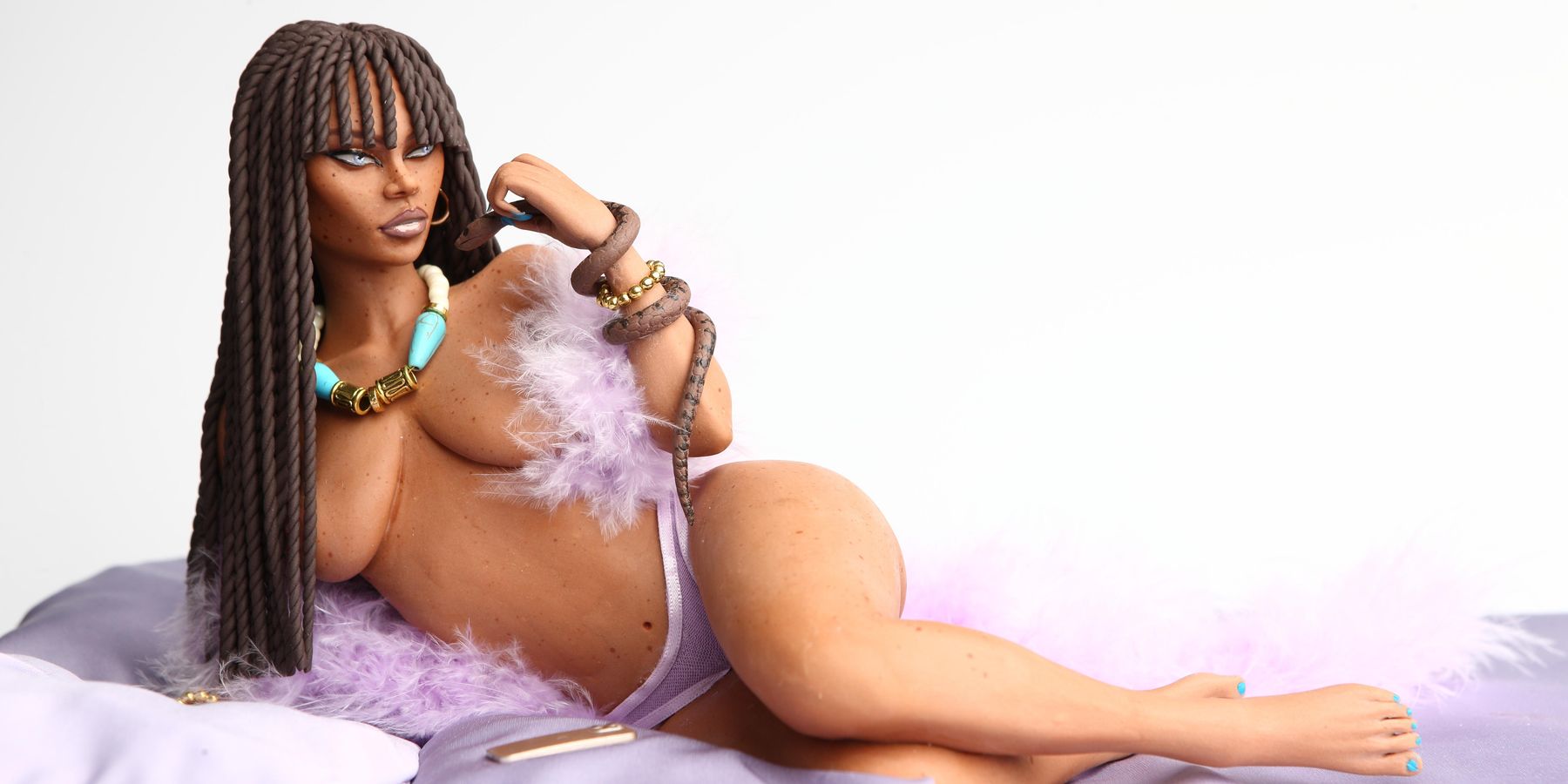
At the opening of his debut US exhibition, South-Caribbean artist PJ Harper shared a story from his childhood about his mom. Whenever they’d shop at a doll store, young Harper fixated on their faces and figures, critiquing the artistry and making suggestions for how the creator could have made them feel more lifelike.
This extreme attention to detail, which so few have and which took root at a remarkably early age, followed Harper into his adult life to ultimately launch his career as a rising multidisciplinary artist, based today in Glasgow.
Now a master doll-maker, Harper’s sculptures have become obsessions across social media for the way they at once reflect and dramatize our contemporary culture. Figures of celebrities and sexy it-girls are reimagined for the internet age, utilizing a foundational understanding of the afro-futurist imagination and classical Greek imagery to create work that looks familiar and surprising in the context of traditional clay figures.
For Harper’s first solo international show, he worked with Good Black Art to assemble “Snakes & Ladders,” featuring more than a dozen sculptures, with corresponding paintings and photo prints inspired by the old board game. “I am really excited and thrilled that Good Black Art has given me this brilliant opportunity and given such amazing support from all of the team,” he says of the project, curated by Good Black Art founder Phil Collins.
Below, Harper tells PAPER about the deeper meaning of “Snakes & Ladders” and his decision to make explicitly queer work for the first time.
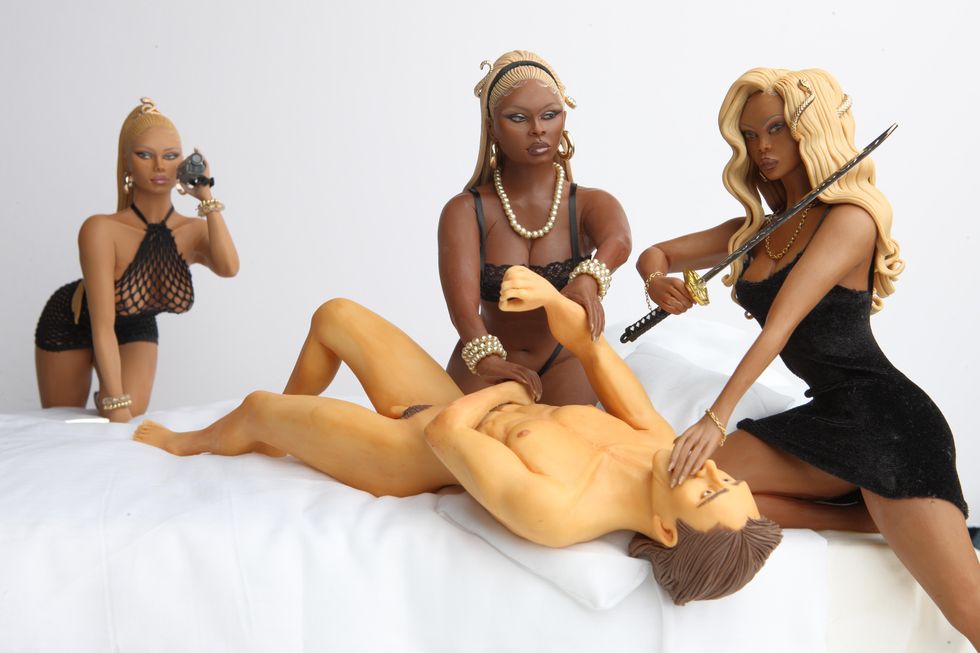
You’re based in Glasglow. How does that environment inform or impact the work that you make?
Glasgow is a great city. It’s small, but it does have a lot of great creatives and very inspiring people who do the best they can with what they have here — whether that be other artists, designers or musicians. I am inspired by them absolutely, but I find a lot of my inspiration through my Caribbean, West Indian heritage. It’s something that I'm so far from in a way, but also close to at the same time.
After creating this body of work, what does the serpent represent in this context? Did its meaning change or evolve as you made the different sculptures?
Initially, when I began this journey for making the work for this exhibit, I was naturally drawn to stories that surrounded ideas and mythologies of serpents: from Medusa to St Paddy to The Garden of Eden. The serpent means a lot of different things in each of these stories: Transformation, rebirth, power, destruction. It was so important for me to tell these stories in a way that shows that there is not just a single meaning for the serpent, and that the snake gives a different context to each story. As I continued with my research, I kept finding the key to each of these stories — and that was the serpent.
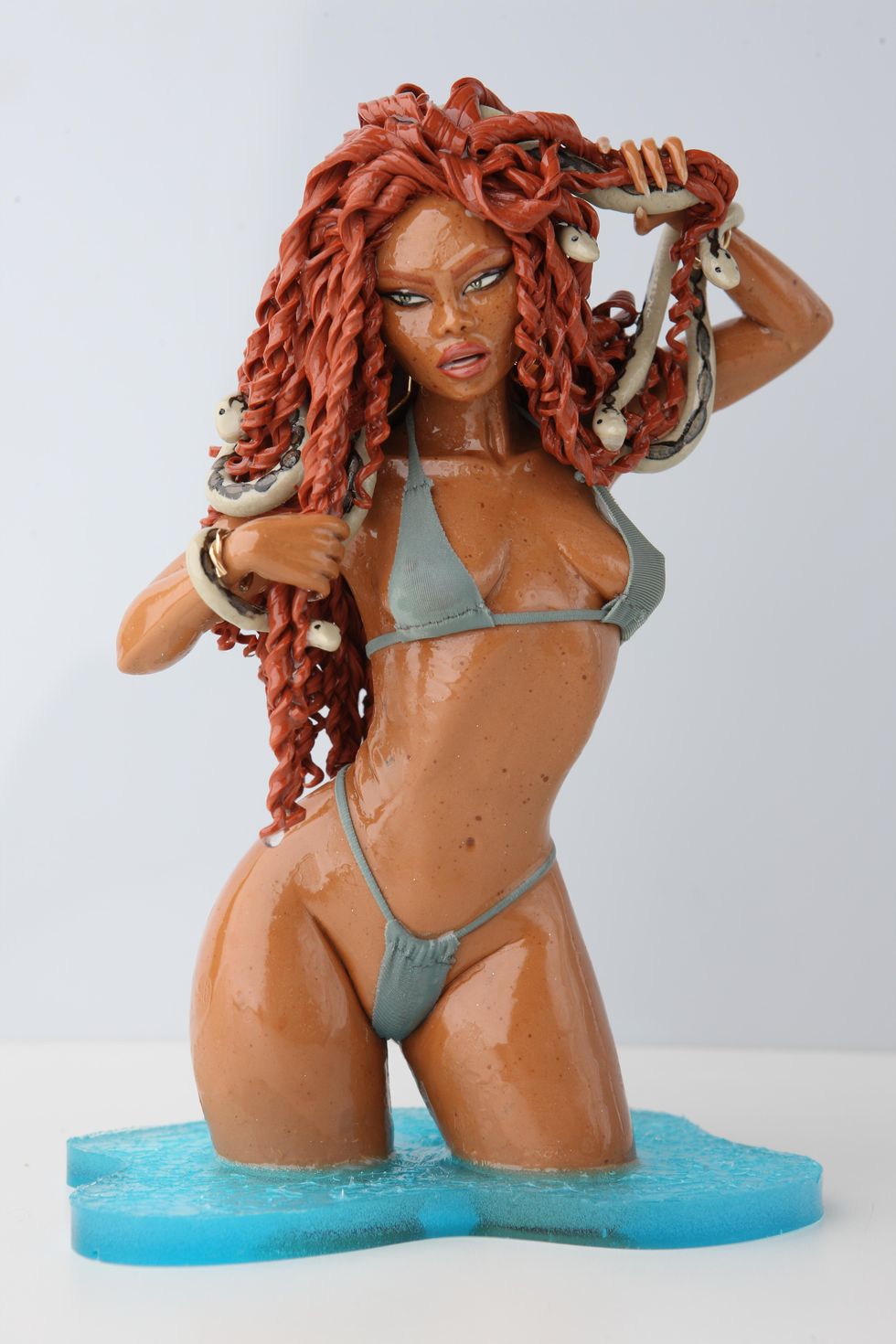
This is your first time making work that’s explicitly queer. Why now? And, for you, what do these sculptures say about queerness?
This was the biggest opportunity to date. I feel like all my work comes from a queer perspective, but not always explicitly. Having had the incredible opportunity thanks to Good Black Art to focus on my story, I wanted to get across what it means to be me — to fully divulge into that was super important to my identity and being.
The conversations I wanted to focus on regarding queerness, stems from my understanding of how the world sees us. I wanted to tackle that from an idea of "the beginning." Nearly all my works in the exhibition stem from religious iconography. Certain people harbor so much hatred against us by using religion as a means to tell us we live a life of sin, when this is simply not the case. We have always existed and we will continue to exist. It was really just about opening a wider conversation about that.
The murder scene is one of the standouts from this body of work, which was a flipped depiction of Patrick Bateman in American Pyscho. What excited you about the prospect of reappropriating that film?
This piece has been in the works for a few years now and I never knew the right time to show this. As soon as I found out I’d be coming to New York City, I knew that this one had to make its appearance. I remember seeing the video cassette tape in my grandmother’s house when I was about 10 years old and being so intrigued by what the movie was about.
Fast forward to now (24 years old) and reading the book, I was horrified. I wanted this to be a take on what would happen to Patrick Bateman had the Furies of Ancient Greek mythology (mixed with old Blaxploitation movies from the '70s) had him get his comeuppance. I loved the way the movie was styled and so those aspects had to be incorporated into the piece. Also, the idea of the beheading stems from the mythology of Medusa. I wanted the female characters of this piece to take away his power. He is the only truly naked sculpture of this exhibition, the rest I consider to be nude.
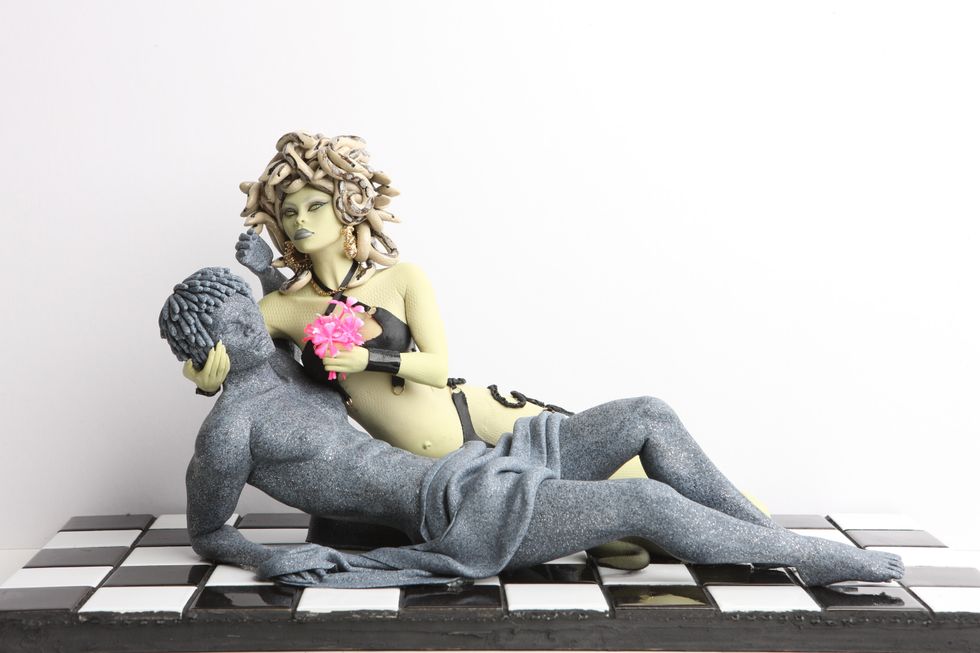
Being your first international solo show, what does "Snakes & Ladders" say about you as an artist? How are these works indicative of your larger mission and point-of-view?
"Snakes and Ladders" is one of the most ancient board games known to us. It began in ancient India and its meaning is spiritual. It's all about life in general — how we can climb the ladders to success and power — but come across a snake and we can fall right back down again. I feel like this was indicative of each of the stories and my understanding of people in a wider sense. Nothing is certain and nothing is permanent. We are ever changing and no one knows what life has in store for us.
What’s the relationship between painting, sculpture and photography, especially in this show? Do you see one, or is it more just a part of your restless creativity?
My real passion is sculpting. I have always been fascinated with 3D objects like dolls and figures. I really enjoy the hands-on approach and the physicality of working with clay, fabric and jewelry. I love the outcome of my drawings, but the process is just not as exciting for me as it is when working with clay. But it’s important for me to do them both. As for photography, I prefer the styling aspect of the medium and how certain aspects of the sculpture can be featured and positioned. In general, though, I find it integral to my creative process to jump from one medium to another. Maybe in the future, I will experiment with film or other types of media.
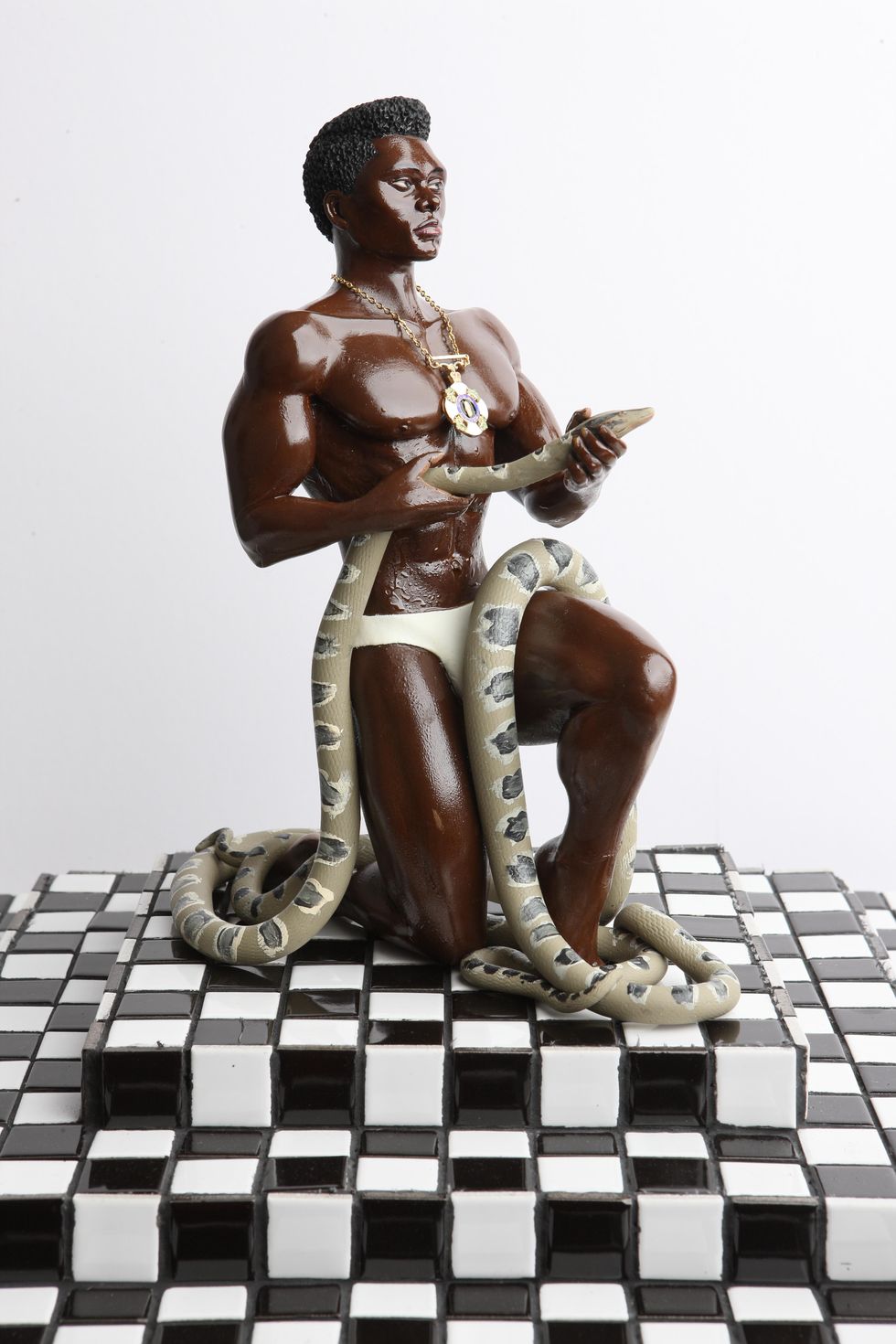
Why do you think your work resonates so strongly on Instagram and social media? Do you consider the reception and audience when you’re making things?
I think it's because lot of my artwork speaks to people who see themselves within my work and the fact that it’s not necessarily a traditional way to use polymer clay, especially showcasing people from the Black Diaspora. I always consider my audience when making the work I do, but, at the same time, this work is my voice and comes from my perspective of the world.
You made this body of work over the course of two months. Do you typically work this quickly, or did this prompt inspire you to work in new ways?
Yes, I do work quite quickly. I think this is perhaps how my brain works, I’m just trying to get my hands to keep up. I am continuously coming up with new ideas and trying to get everything done quickly so I can move onto the next project. In a way, I think social media is to blame for this because we are expected to keep up with such a fast-paced society. But for artists making seriously considered work, it can be a bit overwhelming. When I began making the work for this exhibition, I had a block in August (I was trying to keep up with Instagram), but it ate into my time so the final two months forced me to fully live and breathe my work. I’m working to try and slow down a little, so I can tackle some other ideas. But this will all come with time and I’m excited to see what happens.
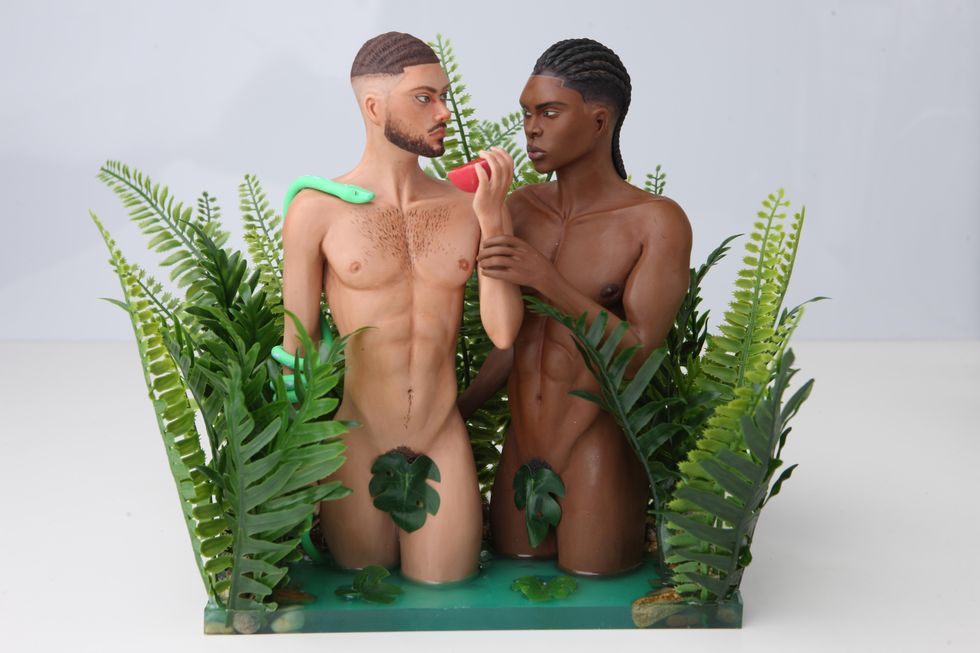
What was the collaboration process like between you and Good Black Art?
Honestly, this has been the most humbling, eye opening and brilliant experience of my life. Working with Good Black Art has been a fantastic journey and a dream come true. Having been connected with Phillip Collins since 2018, and to be in the position I am in today, thanks to him and the rest of the team at Good Black Art, has been something I will treasure forever. It's been incredible to have the privilege of working with them to put on a show in New York City where people who have seen my work over the years online are able to see it in person. It's been amazing hearing the response from people who the work has connected with.
Photos courtesy of PJ Harper and Good Black Art